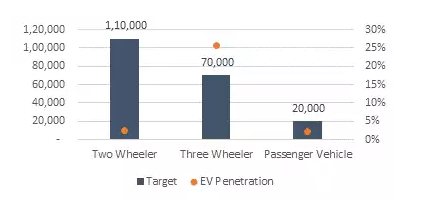• The demand incentive of Rs. 10,000/KwH shall be over and above any subsidies available from the central government, the state government targets 110,000 e2W, 70,000 e3W and 20,000 e4W over the policy period
• The state policy also announced 25% capital subsidy (upto Rs 10. lakh per station) on equipment for the first 250 commercial public EV charging stations, to address infrastructure gaps in the public charging space.

The Government of Gujarat (GoG) has announced the Gujarat State Electric Vehicle Policy 2021 on June 22 with an aim to accelerate electric vehicle (EV) penetration in the state. The policy will be applicable during period of four years commencing from July 01, 2021, and it will entail subsidy for charging infrastructure as well as direct subsidy for personal as well as commercial mobility. The state government targets 110,000 e2W, 70,000 e3W and 20,000 e4W over the policy period. The demand incentive of Rs. 10,000/KwH shall be over and above any subsidies available from the central government. As per ICRA, the changes announced by the GoG are positive, especially for the e2W and e3W segment. Moreover, passenger vehicle for personal usage is covered under state policy, which is currently excluded from FAME II scheme.
On this, Mr. Ashish Modani, Vice President & Sector Head - Corporate Ratings, ICRA, remarked: “As per our estimates, the recent amendment by Department of Heavy Industries as well as incentive by GoG could result in price reduction of about Rs. 30,000 per e2W, which is substantial and will help in achieving price parity with conventional 2W. Another key highlight is the possible price reduction of Rs. 1.5-3 lakh for electric car buyer in Gujarat, as FAME II policy do not provide subsidy to electric cars for personal mobility.”
The state policy also announced 25% capital subsidy (upto Rs. 10 lakh per station) on equipment for the first 250 commercial public EV charging stations, to address infrastructure gaps in the public charging space. The subsidy for charging stations shall only be given to those developers, individuals or entities that have not availed subsidies under any other promotion schemes under the Government of India policies or schemes. The focus on direct incentive for consumers as well as capital subsidy for charging infrastructure roll-out will help in accelerating EV adoption.
Exhibit: Segment wise penetration target (2025) Source: SIAM, ICRA

“The state EV policy if successfully implemented could result in over 25% EV penetration in 3W segment, though its target of 110,000 e2W units over four-year period remain modest as compared to over 1.06 million 2W sold in FY2020 itself,” added Mr. Modan
NEWSLETTER
TRENDING ON PRO MFG
MORE FROM THE SECTION









